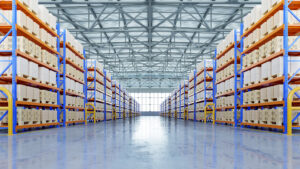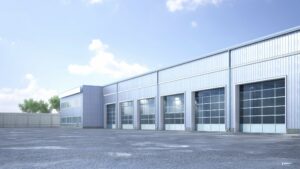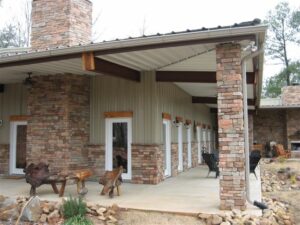Metal warehouses are a popular choice for industrial and commercial applications due to their durability, versatility, and cost-effectiveness. However, before embarking on a construction project, it is crucial to understand the factors that can influence the cost of building a metal warehouse.
In this article, we will delve into the various aspects of metal warehouse construction, breaking down the costs involved, and discussing the impact of size, design, location, and ongoing expenses.
Table of Contents:
- Understanding the Basics of Metal Warehouse Construction
- Breaking Down the Costs of Building a Metal Warehouse
- The Role of Size and Design in Cost Estimation
- Location and Its Effect on Metal Warehouse Construction Costs
- Ongoing Costs Associated with Metal Warehouse Ownership
- Conclusion
- Frequently Asked Questions
Understanding the Basics of Metal Warehouse Construction
Before estimating the cost, it is important to comprehend the basic elements of metal warehouse construction. Metal warehouses can be classified into different types depending on their design, purpose, and layout.
Constructing a metal warehouse involves more than just putting up walls and a roof. It requires careful planning and consideration of various factors to ensure a functional and cost-effective space for storage and operations.
Types of Metal Warehouses
There are several types of metal warehouses, each suited for different needs and requirements:
- Standard steel frame warehouses: These are the most common type, offering durability and flexibility in design.
- Clear span warehouses: These provide uninterrupted open space, ideal for large storage requirements.
- Preengineered metal buildings: These structures are designed and fabricated off-site, then assembled on location, offering a quicker construction timeline.
Choosing the right type of metal warehouse depends on factors such as budget, intended use, and future expansion plans.
Check out: Exploring Different Warehouse Types
Key Factors in Warehouse Construction
When planning to build a metal warehouse, certain factors need to be taken into account to determine the overall cost:
- Size and layout requirements: The size of the warehouse and its layout play a significant role in determining the materials needed and construction complexity.
- Design complexity: Intricate designs or architectural features can add to the overall cost of construction.
- Location and local building codes: Building in different regions may require adherence to specific building codes and regulations, impacting construction costs and timelines.
Considering these factors early in the planning stages can help streamline the construction process and avoid unexpected expenses.
Breaking Down the Costs of Building a Metal Warehouse
Constructing a metal warehouse involves a meticulous breakdown of various cost components to ensure a successful and cost-effective project. In addition to the primary cost factors of materials, labor, and equipment, several other considerations can impact the overall budget.
Cost of Materials
The cost of materials constitutes a significant portion of the total construction budget. Metal warehouses typically require steel frames, roofing, cladding, insulation, and other components.
The price of materials can vary depending on the type, quality, and quantity required. Obtaining quotes from suppliers and comparing prices can help in optimizing material costs.
Additionally, factors such as transportation costs, storage fees, and potential price fluctuations in the market should be taken into account when budgeting for materials.
Check out the blog post: Steel Can Be A Surprisingly Green (And Cost-Effective) Building Material.
Labor Costs
The complexity and scale of the metal warehouse project will directly impact labor costs. Skilled workers, such as drafters, engineers, and construction laborers, play a vital role in ensuring the project’s success. It is crucial to hire experienced professionals who adhere to safety protocols and follow construction standards.
Labor costs may also depend on local wage rates and the availability of skilled workers. Moreover, considerations such as overtime pay, worker benefits, and training expenses should be factored into the labor cost estimation to avoid any unforeseen budget overruns.
Equipment and Machinery Costs
The use of specialized equipment and machinery during construction can contribute to the overall cost.
Cranes, lifts, excavators, and other equipment might be necessary for various tasks such as foundation work, steel erection, and roofing installation.
Renting or purchasing these tools will incur additional expenses that should be factored into the overall budget. It is essential to consider maintenance costs, fuel expenses, and potential equipment rental duration extensions when planning for equipment and machinery expenditures.
The Role of Size and Design in Cost Estimation
Impact of Warehouse Size on Cost
The size of a metal warehouse can significantly influence the total construction cost. Larger warehouses require more materials, take longer to construct, and often require additional labor. Additionally, heating, ventilation, and lighting costs can be higher for larger spaces. Determining the optimal size that meets the project’s requirements while keeping costs manageable is essential.
When considering the size of a warehouse, it is important to factor in future expansion needs.
Building a slightly larger warehouse than currently required can potentially save costs in the long run by avoiding the need for a costly expansion project in the future. However, striking the right balance between current needs and future growth projections is key to optimizing cost-efficiency.
Influence of Design Complexity on Price
The design complexity of a metal warehouse can impact the construction cost in several ways. Intricate architectural details, nonstandard shapes, and unique features can increase material and labor requirements, as well as the overall construction timeline.
Collaborating with experienced architects and discussing design options that balance aesthetics and affordability is crucial to controlling costs.
Furthermore, innovative design elements such as sustainable materials and energy-efficient systems can initially raise construction costs but lead to long-term savings through reduced operational expenses.
Integrating green building practices not only benefits the environment but also enhances the overall value and marketability of the warehouse in the increasingly eco-conscious real estate market.
Pro tip:
Steel maximizes expansion and flexibility of warehouses through clearspan construction which eliminates the need for internal columns. This creates wide-open, adaptable car storage spaces, allowing for easy rearrangement as needed.
Location and Its Effect on Metal Warehouse Construction Costs
When it comes to constructing a metal warehouse, the location you choose can significantly influence the overall project costs.
From land acquisition to adhering to local building codes, various factors come into play that can impact the budget and timeline of the construction process.
Land Acquisition and Preparation Costs
Choosing the right location for your metal warehouse involves more than just finding a suitable piece of land. In addition to the purchase or lease costs of the property, there are several other expenses to consider.
Site surveys and soil tests are essential to assess the condition of the land and determine its suitability for construction. These initial assessments help in understanding the foundation requirements and potential challenges that may arise during the building process.
Moreover, obtaining building permits and approvals from local authorities is a crucial step that incurs its own set of costs. Site preparation, including grading, excavation, and utility connections, also plays a vital role in laying the groundwork for the construction project and can impact the overall budget significantly.
Did You Know?
SteelCo assists valued clients through every step of designing and building a metal warehouse, including obtaining the necessary permits.
Impact of Local Building Codes and Regulations
Local building codes and regulations are another key factor to consider when planning the construction of a metal warehouse. These regulations dictate specific requirements related to safety standards, energy efficiency, and environmental considerations that must be met during the construction process.
Ensuring compliance with these regulations may involve using certain materials, equipment, and construction techniques that could affect the overall cost of the project.
Consulting with local authorities early in the planning stages and understanding the relevant guidelines can help avoid costly delays and modifications later on.
Pro tip:
A warehouse isn’t always a clear zoning category. Projects might fall under industrial, commercial, or mixed-use zoning codes, making it hard to identify warehouses within broader datasets. It’s best to work with experienced professionals when deciding on zoning.
Ongoing Costs Associated with Metal Warehouse Ownership
Maintenance and Repair Costs
After construction, ongoing maintenance and repair costs should be considered. Metal warehouses require regular inspections, maintenance of roofing and cladding, and periodic repairs to ensure their longevity and functionality.
Factoring in these costs during the planning phase can help in estimating the long-term expenses associated with warehouse ownership.
It is essential to establish a proactive maintenance schedule to address issues promptly and prevent costly repairs down the line. Regular inspections can identify potential problems early on, allowing for timely interventions that can extend the lifespan of the warehouse structure.
Additionally, investing in high-quality materials and professional maintenance services can contribute to the overall durability and efficiency of the metal warehouse.
Also, check out the blog post: Winter Maintenance Tips For Steel Buildings.
Insurance and Tax Considerations
They also contribute to the overall cost of owning a metal warehouse. Insurance premiums will depend on factors such as the warehouse’s location, size, and contents.
Property taxes and other applicable taxes vary depending on local regulations and policies. Consulting with insurance providers and tax professionals can provide a better understanding of these ongoing financial obligations.
Furthermore, it is crucial to review insurance policies regularly to ensure adequate coverage for potential risks such as natural disasters, theft, or structural damage.
Understanding the tax implications of warehouse ownership, including depreciation schedules and deductions, can help in effective financial planning and budgeting for the long term.
Generally, steel building insurance is less expensive than other building materials due to their structural stability, fire resistance, and cost efficiency.

Conclusion
Building a metal warehouse involves assessing multiple factors that influence the overall cost. Understanding the basics of metal warehouse construction, breaking down the costs, considering the role of size, design, and location, and recognizing ongoing expenses are essential for accurate cost estimation and successful project planning.
By carefully evaluating these factors, stakeholders can make informed decisions and ensure the cost-effective realization of their metal warehouse construction projects.
SteelCo has been a top provider of metal warehouse materials across the country for over 23 years. We also offer comprehensive design and construction services in GA. Our team comprises highly experienced and knowledgeable professionals who are committed to delivering customized warehouses that meet your unique expectations and requirements. Learn more about our construction services.
————————-
Frequently Asked Questions
How much does it cost to build a warehouse from scratch?
Accurately pricing warehouses can be tricky due to the various customizations involved. However, a rough estimate for a basic warehouse in 2024 typically ranges from $17 to $20 per square foot for PEMB materials, $6 to $10 for building erection, and approximately $110 to $150 SF for full construction costs (materials and construction, under 100k SF project sizes). It’s important to note that this estimate can vary significantly depending on supply and demand dynamics, as well as other market factors.
How much does it cost to build a 10,000 sq ft warehouse?
Based on the cost of $110 to $150 per SF for full construction costs (materials and construction, under 100k SF project sizes), a rough estimate for a 10,000-square-foot warehouse would cost between $1,100,000 to $1,500,000.
———————–
Check out these related articles:
> A Step-By-Step Guide On How To Build A Warehouse
> How Do I Get A Permit For My Warehouse?
























